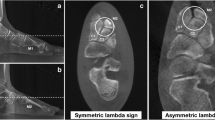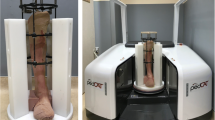Abstract
Introduction
Subtle Lisfranc injuries (SLIs) are challenging to diagnose. Although weightbearing (WB) radiographs have been suggested to identify SLIs, approximately 20% are missed on initial radiographic assessment. Computed tomography (CT) has been suggested as an alternative, but has not provided any diagnostic guideline. Therefore we compared measurement techniques on radiographs and bilateral foot CT scans for the efficiency of diagnosis and making surgical decisions for SLI.
Methods
We retrospectively investigated patients diagnosed with SLIs between January 2014 and January 2020. Distances between both medial cuneiform and second metatarsal base (C1M2), and the first and second metatarsal bases (M1M2), were measured on bilateral WB radiographs. Bilateral foot CT scans were taken, and the distances between C1M2 were checked on the axial and three points of the coronal plane (top, middle, and base). The surgical indication was > 1 mm of diastasis on CT scan. Clinical outcomes were evaluated using the American Orthopaedic Foot and Ankle Society (AOFAS) score at final follow-up. Intraobserver and interobserver agreements were assessed.
Results
Thirty patients with SLIs were reviewed. Twenty-four patients underwent surgical fixation (Group A) and six patients were treated conservatively (Group B). The side-to-side difference (STSD) of C1M2 and M1M2 distances greater than 1 mm showed 91.7% and 54.2% sensitivity, and 66.7% and 16.7% specificity, respectively. Investigating STSDs of all points on CT scans were informative to discriminate both groups (P ≤ 0.038). Clinical outcomes showed no significant difference between the groups (P = 0.631). Intraclass and interclass correlation coefficient values showed good to very good reliability, except for STSD of WB M1M2 distance and the coronal top plane.
Conclusion
Investigating bilateral foot CT scans was significantly efficient and reliable for the diagnosis and treatment plan for SLI. On radiographs, STSD of WB C1M2 distance was more sensitive than STSD of WB M1M2 distance.
Level of evidence
Case control study; III.


Similar content being viewed by others
References
Alberta FG, Aronow MS, Barrero M, Diaz-Doran V, Sullivan RJ, Adams DJ (2005) Ligamentous Lisfranc joint injuries: a biomechanical comparison of dorsal plate and transarticular screw fixation. Foot Ankle Int 26:462–473
Altman DG (2020) Practical statistics for medical research Chapman and Hall, second edition. London and New York
Arntz CT, Veith RG, Hansen ST Jr (1988) Fractures and fracture-dislocations of the tarsometatarsal joint. J Bone Jt Surg Am 70:173–181
Backer HC, Vosseller JT (2020) Fibula fracture: plate versus nail fixation. Clin Orthop Surg 12:529–534
Chan BY, Markhardt BK, Williams KL, Kanarek AA, Ross AB (2019) Os conundrum: identifying symptomatic sesamoids and accessory ossicles of the foot. AJR Am J Roentgenol 213:417–426
Choi JY, Yu OJ, Suh JS (2021) Factors influencing postoperative residual diastasis after the operative treatment of acute Lisfranc fracture dislocation. Arch Orthop Trauma Surg. https://doi.org/10.1007/s00402-021-04058-w
Coss HS, Manos RE, Buoncristiani A, Mills WJ (1998) Abduction stress and AP weightbearing radiography of purely ligamentous injury in the tarsometatarsal joint. Foot Ankle Int 19:537–541
Curtis MJ, Myerson M, Szura B (1993) Tarsometatarsal joint injuries in the athlete. Am J Sports Med 21:497–502
Ebraheim NA, Yang H, Lu J, Biyani A (1996) Computer evaluation of second tarsometatarsal joint dislocation. Foot Ankle Int 17:685–689
Eleftheriou KI, Rosenfeld PF, Calder JD (2013) Lisfranc injuries: an update. Knee Surg Sports Traumatol Arthrosc 21:1434–1446
Faciszewski T, Burks RT, Manaster BJ (1990) Subtle injuries of the Lisfranc joint. J Bone Jt Surg Am 72:1519–1522
Gupta RT, Wadhwa RP, Learch TJ, Herwick SM (2008) Lisfranc injury: imaging findings for this important but often-missed diagnosis. Curr Probl Diagn Radiol 37:115–126
Haapamaki V, Kiuru M, Koskinen S (2004) Lisfranc fracture-dislocation in patients with multiple trauma: diagnosis with multidetector computed tomography. Foot Ankle Int 25:614–619
Haapamaki VV, Kiuru MJ, Koskinen SK (2004) Ankle and foot injuries: analysis of MDCT findings. AJR Am J Roentgenol 183:615–622
Kalia V, Fishman EK, Carrino JA, Fayad LM (2012) Epidemiology, imaging, and treatment of Lisfranc fracture-dislocations revisited. Skeletal Radiol 41:129–136
Kitsukawa K, Hirano T, Niki H, Tachizawa N, Nakajima Y, Hirata K (2015) MR imaging evaluation of the lisfranc ligament in cadaveric feet and patients with acute to chronic Lisfranc injury. Foot Ankle Int 36:1483–1492
Knijnenberg LM, Dingemans SA, Terra MP, Struijs PAA, Schep NWL, Schepers T (2018) Radiographic anatomy of the pediatric Lisfranc joint. J Pediatr Orthop 38:510–513
Kuo RS, Tejwani NC, Digiovanni CW, Holt SK, Benirschke SK, Hansen ST Jr, Sangeorzan BJ (2000) Outcome after open reduction and internal fixation of Lisfranc joint injuries. J Bone Jt Surg Am 82:1609–1618
Lu J, Ebraheim NA, Skie M, Porshinsky B, Yeasting RA (1997) Radiographic and computed tomographic evaluation of Lisfranc dislocation: a cadaver study. Foot Ankle Int 18:351–355
Ly TV, Coetzee JC (2006) Treatment of primarily ligamentous Lisfranc joint injuries: primary arthrodesis compared with open reduction and internal fixation. A prospective, randomized study. J Bone Jt Surg Am 88:514–520
Malhotra G, Cameron J, Toolan BC (2014) Diagnosing chronic diastasis of the syndesmosis: a novel measurement using computed tomography. Foot Ankle Int 35:483–488
Nunley JA, Vertullo CJ (2002) Classification, investigation, and management of midfoot sprains: Lisfranc injuries in the athlete. Am J Sports Med 30:871–878
Panchbhavi VK, Andersen CR, Vallurupalli S, Yang J (2008) A minimally disruptive model and three-dimensional evaluation of Lisfranc joint diastasis. J Bone Jt Surg Am 90:2707–2713
Pearce CJ, Calder JD (2010) Surgical anatomy of the midfoot. Knee Surg Sports Traumatol Arthrosc 18:581–586
Peicha G, Labovitz J, Seibert FJ, Grechenig W, Weiglein A, Preidler KW, Quehenberger F (2002) The anatomy of the joint as a risk factor for Lisfranc dislocation and fracture-dislocation. An anatomical and radiological case control study. J Bone Jt Surg Br 84:981–985
Ponkilainen VT, Partio N, Salonen EE, Laine HJ, Maenpaa HM, Mattila VM, Haapasalo HH (2021) Outcomes after nonoperatively treated non-displaced Lisfranc injury: a retrospective case series of 55 patients. Arch Orthop Trauma Surg 141:1311–1317
Ponkilainen VT, Partio N, Salonen EE et al (2020) Inter- and intraobserver reliability of non-weight-bearing foot radiographs compared with CT in Lisfranc injuries. Arch Orthop Trauma Surg. https://doi.org/10.1007/s00402-020-03391-w
Potter HG, Deland JT, Gusmer PB, Carson E, Warren RF (1998) Magnetic resonance imaging of the Lisfranc ligament of the foot. Foot Ankle Int 19:438–446
Preidler KW, Brossmann J, Daenen B, Goodwin D, Schweitzer M, Resnick D (1996) MR imaging of the tarsometatarsal joint: analysis of injuries in 11 patients. AJR Am J Roentgenol 167:1217–1222
Rankine JJ, Nicholas CM, Wells G, Barron DA (2012) The diagnostic accuracy of radiographs in Lisfranc injury and the potential value of a craniocaudal projection. AJR Am J Roentgenol 198:W365-369
Rosenbaum A, Dellenbaugh S, Dipreta J, Uhl R (2011) Subtle injuries to the Lisfranc joint. Orthopedics 34:882–887
Saxena A, Eakin C (2007) Articular talar injuries in athletes: results of microfracture and autogenous bone graft. Am J Sports Med 35:1680–1687
Seo DK, Lee HS, Lee KW, Lee SK, Kim SB (2017) nonweightbearing radiographs in patients with a subtle Lisfranc injury. Foot Ankle Int 38:1120–1125
Siddiqui NA, Galizia MS, Almusa E, Omar IM (2014) Evaluation of the tarsometatarsal joint using conventional radiography, CT, and MR imaging. Radiographics 34:514–531
Sivakumar BS, An VVG, Oitment C, Myerson M (2018) Subtle Lisfranc injuries: a topical review and modification of the classification system. Orthopedics 41:e168–e175
Solan MC, Moorman CT 3rd, Miyamoto RG, Jasper LE, Belkoff SM (2001) Ligamentous restraints of the second tarsometatarsal joint: a biomechanical evaluation. Foot Ankle Int 22:637–641
Sripanich Y, Steadman J, Krahenbuhl N, Rungprai C, Mills MK, Saltzman CL, Barg A (2020) Asymmetric lambda sign of the second tarsometatarsal joint on axial weight-bearing cone-beam CT scans of the foot: preliminary investigation for diagnosis of subtle ligamentous Lisfranc injuries in a cadaveric model. Skeletal Radiol. https://doi.org/10.1007/s00256-020-03445-5
Sripanich Y, Weinberg M, Krahenbuhl N, Rungprai C, Saltzman CL, Barg A (2020) Change in the first cuneiform-second metatarsal distance after simulated ligamentous Lisfranc injury evaluated by weightbearing CT scans. Foot Ankle Int 41:1432–1441
Sripanich Y, Weinberg MW, Krahenbuhl N, Rungprai C, Mills MK, Saltzman CL, Barg A (2020) Imaging in Lisfranc injury: a systematic literature review. Skeletal Radiol 49:31–53
Sripanich Y, Weinberg MW, Krahenbuhl N, Rungprai C, Saltzman CL, Barg A (2021) Reliability of measurements assessing the Lisfranc joint using weightbearing computed tomography imaging. Arch Orthop Trauma Surg 141:775–781
Stavlas P, Roberts CS, Xypnitos FN, Giannoudis PV (2010) The role of reduction and internal fixation of Lisfranc fracture-dislocations: a systematic review of the literature. Int Orthop 34:1083–1091
Stein RE (1983) Radiological aspects of the tarsometatarsal joints. Foot Ankle 3:286–289
Tang CW, Roidis N, Vaishnav S, Patel A, Thordarson DB (2003) Position of the distal fibular fragment in pronation and supination ankle fractures: a CT evaluation. Foot Ankle Int 24:561–566
Thompson MC, Mormino MA (2003) Injury to the tarsometatarsal joint complex. J Am Acad Orthop Surg 11:260–267
Vuori JP, Aro HT (1993) Lisfranc joint injuries: trauma mechanisms and associated injuries. J Trauma 35:40–45
Watson TS, Shurnas PS, Denker J (2010) Treatment of Lisfranc joint injury: current concepts. J Am Acad Orthop Surg 18:718–728
Yu-Kai Y, Shiu-Bii L (2015) Anatomic parameters of the Lisfranc joint complex in a radiographic and cadaveric comparison. J Foot Ankle Surg 54:883–887
Funding
No funds, grants, or other support was received.
Author information
Authors and Affiliations
Contributions
Conceptualization: DWS. Data curation: EC, DWS, SCS. Formal analysis: S-YS, JWL. Funding acquisition: N/A. Investigation: DWS, EC, Y-CP, SCS. Methodology: S-YS, JWL. Project administration: JWL, Y-CP. Resources: EC, DWS, SCS. Software: DWS, Y-CP. Supervision: JWL. Validation: Y-CP, S-YS. Visualization: DWS, JWL, S-YS. Writing—original draft: DWS. Writing—review and editing: S-YS.
Corresponding author
Ethics declarations
Conflict of interest
The authors have no relevant financial or non-financial interests to disclose.
Ethical approval
This study was approved by the Catholic Kwandong University International St. Mary’s Institutional Review Board (IS20RISI0058).
Consent to participate
Not applicable.
Additional information
Publisher's Note
Springer Nature remains neutral with regard to jurisdictional claims in published maps and institutional affiliations.
Rights and permissions
About this article
Cite this article
Shim, D.W., Choi, E., Park, YC. et al. Comparing bilateral feet computed tomography scans can improve surgical decision making for subtle Lisfranc injury. Arch Orthop Trauma Surg 142, 3705–3714 (2022). https://doi.org/10.1007/s00402-021-04182-7
Received:
Accepted:
Published:
Issue Date:
DOI: https://doi.org/10.1007/s00402-021-04182-7




